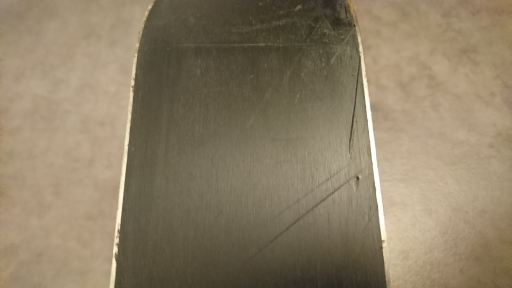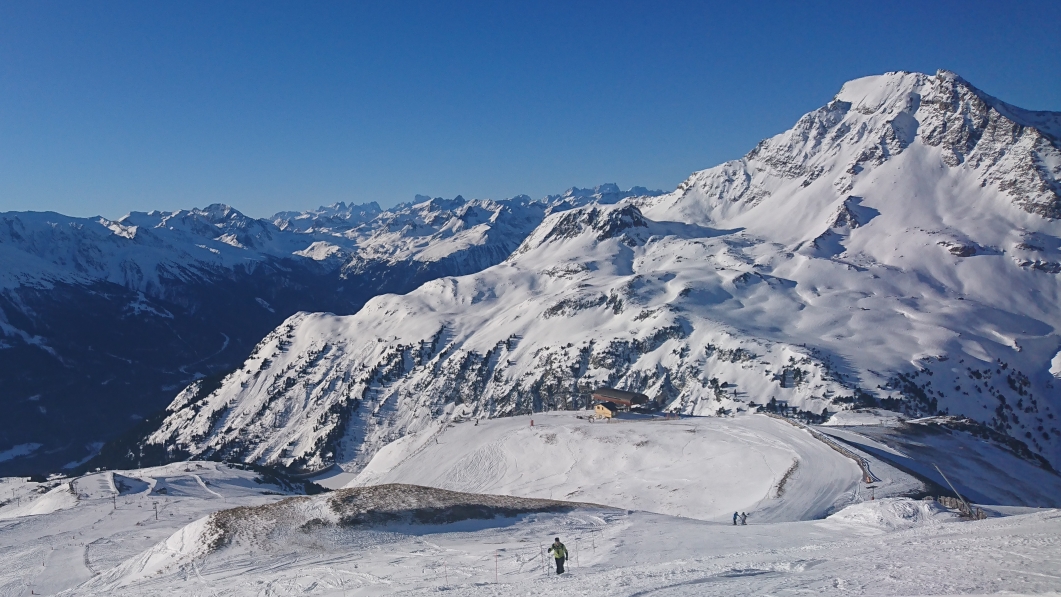Ski season is here, but are your skis ready to go? We don’t always think about ski maintenance, but there are several things you should check before you ski down your first slope. If it looks like your skis need some repairs, go to a reputable ski shop in your area. They can tune your skis and check your bindings. Before you know it, you’ll be all set for your next adventure!
Is this article difficult to understand? Go to the adapted version!
The Base
The base of your ski is the bottom of your ski. Getting scrapes and dings on the bottom of your skis is common, but sometimes they take a really big hit. Skiing when there isn’t a lot of snow on the ground increases your chances of hitting some rocks.
If you do make contact, you probably have a gash or two on the bottom of your skis. These need to be filled, so be sure to check them over for any damage. It may not seem important, but if the base of the ski isn’t smooth, you won’t glide well.

The Edges
Edges are the pieces of metal on the sides of skis. They help skis grip the snow during turns. Skis don’t perform at their best if there are signs of rust, burrs, or scrapes on the edges.
When you take a close look at your skis, don’t worry if you see some rust. If there isn’t a lot, it can usually be polished out. But, be sure to remove it before it gets worse.

Like the base of your skis, edges are also prone to scrapes. If they aren’t too deep, these can be smoothed out to help your skis glide more easily.
Burrs are small bumps of metal that form on the edges. They can be removed most of the time, but be careful when you’re skiing!
If there is extensive damage due to burrs or scrapes, the edges must be replaced.
The Wax
The most common form of ski maintenance is waxing your skis. If they don’t have a good coat of wax on them, they don’t glide well. But how can you tell if they need to be waxed?
If the bottoms of the skis look dry, white, and cloudy, these are signs that you need to wax your skis. A good rule of thumb is to wax them after every three or four outings.

The Bindings
Bindings are often overlooked, but they shouldn’t be ignored! Are there any loose screws or broken parts? Are they worn down?
If your bindings are getting old or if you did a lot of aggressive skiing last season, it’s important to get them checked out by a professional. Each binding is set to release a ski boot with a certain amount of force.
With an incorrect setting, the ski boot will release unexpectedly and may cause serious injury. To determine the correct DIN setting, it’s necessary to consider the skier’s height, weight, and ability level.

Conclusion
When the snow comes early, and you can’t wait to hit the slopes, it’s not easy to take the time to do proper ski maintenance. Just remember that when you take care of your skis, you will glide more easily, AND you’ll be skiing safer. Who doesn’t want that?
So before you head out, be sure to tune your skis and check your bindings!
See you on the slopes!
Adapted Version
Ski Season Has Started – Are Your Skis Ready?
In parenthesis () there are explanations of words and phrases. These explanations are in italics.
Ski season is here (has arrived), but are your skis ready to go (ready for skiing)? We don’t always think about ski maintenance, but there are several things you should check (verify) before you ski down your first slope. If it looks like (appears that) your skis need some repairs, go to a reputable (good-quality) ski shop in your area. They can tune (examine and repair) your skis and check your bindings. Before you know it (quickly), you’ll be all set (ready) for your next adventure!
The Base
The base of your ski is the bottom of your ski. Getting scrapes (abrasion) and dings (small holes) on the bottom of your skis is common (normal), but sometimes they take a really big hit (severely damaged). Skiing when there isn’t a lot of snow on the ground increases your chances of hitting some rocks.
If you do make contact, you probably have a gash (big abrasion) or two on the bottom of your skis. These need to be filled (made flat and even), so be sure to check them over (verify) for any damage. It may not seem important, but if the base of the ski isn’t smooth (flat), you won’t glide (move without friction) well.

The Edges
Edges are the pieces of metal on the sides of skis. They help skis grip (adhere to) the snow during turns. Skis don’t perform at their best if there are signs of rust (brown marks from oxidation), burrs (bumps on metal, not smooth), or scrapes (abrasions) on the edges.
When you take a close look at (examine) your skis, don’t worry (become anxious) if you see some rust. If there isn’t a lot, it can usually be polished out (eliminated). Be sure to remove it before it gets worse.

Like the base of your skis, edges are also prone to (known to have) scrapes. If they are not too deep, these can be smoothed out to help your skis glide more easily.
Burrs are small bumps of metal that form on the edges. They can be removed most of the time, but be careful when you’re skiing!
If there is extensive (a lot of) damage due to burrs or scrapes, the edges must be replaced.
The Wax
The most common form of ski maintenance is waxing your skis. If they don’t have a good coat (layer) of wax on them, they don’t glide well. But how can you tell (know) if they need to be waxed?
If the bottoms of the skis look dry, white, and cloudy (have a white layer), these are signs that you need to wax your skis. A good rule of thumb (basic rule) is to wax them after every three or four outings (times you go skiing).

The Bindings
Bindings are often overlooked (neglected), but they shouldn’t be ignored (forgotten)! Are there any loose (not tight) screws or broken parts? Are they worn down (damaged from being used)?
If your bindings are getting old or if you did a lot of aggressive skiing last season, it’s important to get them checked out by a professional. Each binding is set to release (disengage) a ski boot with a certain amount of force.
With an incorrect setting, the ski boot will release unexpectedly (without warning) and may cause serious injury. To determine the correct DIN setting, it’s necessary to consider the skier’s height, weight, and ability level.

Conclusion
When the snow comes early, and you can’t wait to hit the slopes, it’s not easy to take the time to do proper (correct) ski maintenance. Just remember that when you take care of (maintain) your skis, you will glide more easily, AND you’ll be skiing safer. Who doesn’t want that?
So before you head out (leave to go skiing), be sure to tune (maintain) your skis and check your bindings!
See you on the slopes!


